In 1888 when Heinrich Hertz first transmitted radio waves over a distance of a few paces in his Karlsruhe, Germany, laboratory, no one could have predicted the vast global and interplanetary radio communication systems of today or that radio telescopes would detect quasars at distances of more than 10 billion light-years. Although neutrino communication is now in a primitive state, like radio in Hertz's time, who can foresee what its capabilities may be 100 years from now?
In this fascinating article, Jay Pasachoff and Marc Kutner assess the "state of the art" and consider its potential for bridging interstellar distances. — Eds.
Though no interstellar communication is going to be quick, it is obviously better to send messages that travel at the highest possible velocity, all other things being equal. Usually this leads to the conclusion that we should communicate with radio or other electromagnetic waves. But one nuclear particle—the neutrino—travels at the speed of light, and the possibilities of using neutrinos as the vehicle for interstellar communication should be carefully explored. Neutrinos turn out to have many advantages for this purpose, along with their major difficulties, and we think that investigation of neutrino communication should not be ignored. We note that we are here exploring possibilities whose realization would be in the distant future. Nonetheless, since most other communicating civilizations would be far more advanced than our own, it is an interesting exercise to examine alternative means by which interstellar communication may have evolved.
Neutrinos
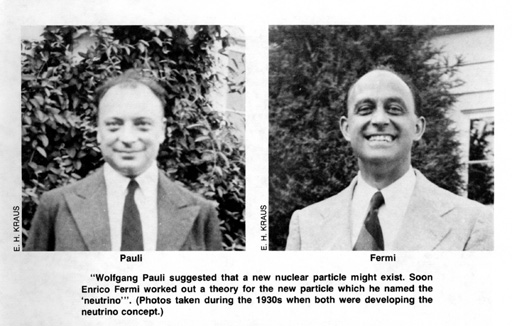 In the early 1930's, Wolfgang Pauli suggested that a new nuclear particle might exist to explain the apparent lack of conservation of energy and spin in beta decay, a radioactive process that involves the emission of an electron (a beta
particle). Soon Enrico Fermi worked out a theory for the new particle, which he named "neutrino," Italian for "little
neutral one," since the particle had no charge and to distinguish it from the "neutron," which had recently been discovered.
In the early 1930's, Wolfgang Pauli suggested that a new nuclear particle might exist to explain the apparent lack of conservation of energy and spin in beta decay, a radioactive process that involves the emission of an electron (a beta
particle). Soon Enrico Fermi worked out a theory for the new particle, which he named "neutrino," Italian for "little
neutral one," since the particle had no charge and to distinguish it from the "neutron," which had recently been discovered.
The neutrino is, therefore, a particle with no charge but with a certain energy and a certain spin. It travels at the speed of light, and in order to do so, it must have no rest mass.
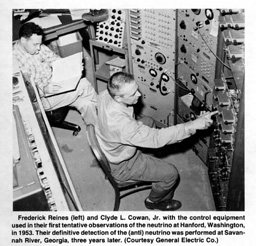 Neutrinos are the most elusive particles of which we know. They have a very low probability of interacting with any other matter. In fact, neutrinos on the average can penetrate four light years of lead before being stopped. Rather than try to detect individual neutrinos, we normally resort to capturing a tiny fraction of a huge number of neutrinos. In this way, Frederick Reines and Clyde L. Cowan, Jr., detected antineutrinos in 1956 in the flood of particles coming from the Savannah River reactor. The existence of antineutrinos shows neutrinos too must exist.
Neutrinos are the most elusive particles of which we know. They have a very low probability of interacting with any other matter. In fact, neutrinos on the average can penetrate four light years of lead before being stopped. Rather than try to detect individual neutrinos, we normally resort to capturing a tiny fraction of a huge number of neutrinos. In this way, Frederick Reines and Clyde L. Cowan, Jr., detected antineutrinos in 1956 in the flood of particles coming from the Savannah River reactor. The existence of antineutrinos shows neutrinos too must exist.
The disadvantage that neutrinos interact so weakly with matter is also an advantage, because this property allows neutrinos to escape from the center of a star. The nuclear fusion cycles that fuel our sun lead to the emission of neutrinos of relatively low energy. These neutrinos come straight out of the solar core, reaching the radius of the earth's orbit in 8 minutes, thus providing us with our only direct link to the solar core.
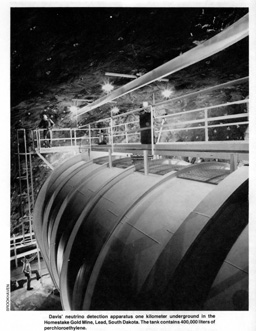 Raymond Davis, Jr., of the Brookhaven National Laboratory, has set up a 400,000 liter tank of perchloroethylene (a type of cleaning fluid, C2Cl4) to capture solar neutrinos. His tank is located deep underground in a gold mine (at Lead, South Dakota), where it is shielded by the earth and rock above from other particles that would cause reactions
in his material. He is now detecting 1.8 (±0.4) Solar Neutrino Units (SNUs) of neutrinos (where one SNU corresponds to 10-36 captures per chlorine atom per day, or one capture per day among a trillion, trillion, trillion atoms). This amounts to about one interaction every six days.
Raymond Davis, Jr., of the Brookhaven National Laboratory, has set up a 400,000 liter tank of perchloroethylene (a type of cleaning fluid, C2Cl4) to capture solar neutrinos. His tank is located deep underground in a gold mine (at Lead, South Dakota), where it is shielded by the earth and rock above from other particles that would cause reactions
in his material. He is now detecting 1.8 (±0.4) Solar Neutrino Units (SNUs) of neutrinos (where one SNU corresponds to 10-36 captures per chlorine atom per day, or one capture per day among a trillion, trillion, trillion atoms). This amounts to about one interaction every six days.
Davis' results are lower by a factor of almost three than the best current predictions of the solar neutrino outflow, but within about twice the error (standard deviation) in the theoretical predictions, which give 4.7 (±1.4) SNU. He is planning an experiment using gallium rather than the chlorine presently in his tank, and a Soviet group is also planning a gallium experiment. Gallium is sensitive to lower-energy neutrinos than is chlorine.
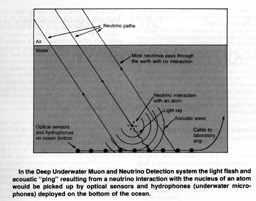 Still higher energy neutrinos should be emitted in supernova explosions. Such neutrinos might be detected by an apparatus being considered in Project DUMAND (Deep Underwater Muon and Neutrino Detection). One plan involves setting up acoustic or optical detectors over an area of several square kilometers on the floor of the Pacific Ocean near Hawaii to detect the Cerenkov radiation emitted when neutrinos interact with nucleons in the water. (Cerenkov radiation is emitted when a particle enters a medium travelling faster than the speed of light in that medium, somewhat analogous to a sonic boom.)
Still higher energy neutrinos should be emitted in supernova explosions. Such neutrinos might be detected by an apparatus being considered in Project DUMAND (Deep Underwater Muon and Neutrino Detection). One plan involves setting up acoustic or optical detectors over an area of several square kilometers on the floor of the Pacific Ocean near Hawaii to detect the Cerenkov radiation emitted when neutrinos interact with nucleons in the water. (Cerenkov radiation is emitted when a particle enters a medium travelling faster than the speed of light in that medium, somewhat analogous to a sonic boom.)
Though neutrinos are very difficult to detect, the scientific benefits of studying the neutrinos that result from stellar interiors or supernovae have made it worthwhile to set up equipment to study them. Continued improvements in the sensitivity of neutrino detection devices can be expected.
Advantages of Neutrino Communication
Much discussion of SETI has been taken up with finding a suitable frequency for radio communication. Interesting arguments have been advanced for 21 centimeters, the water hole, and other wavelengths. It is hard to reason satisfactorily on this subject; only the detection of a signal will tell us whether or not we are right. Neutrino detection schemes, on the other hand, are broad band, that is, the apparatus is sensitive to neutrinos of a wide energy range. The fact that neutrinos pass through the earth would also be an advantage, because detectors would be omnidirectional. Thus, the whole sky can be covered by a single detector. It is perhaps reasonable to search for messages from extraterrestrial civilizations by looking for the neutrinos they are transmitting, and then switch to electromagnetic means for further conversations.
"It may well be that neutrinos are considered by extraterrestrial civilizations to be a more advanced method of communication than radio waves."
Though the means of detecting neutrinos are now relatively insensitive, we must remember that we are in the dawn of the age of neutrino detection. It is only 23 years since the first antineutrinos were detected. It is almost a hundred years, on the other hand, since the detection of radio waves, and our sensitivity to them has increased manyfold. We can expect that in the next decades we will be better able to detect neutrinos from space, both those arising naturally from astronomical phenomena and those carrying messages from extraterrestrial civilizations. It may well be that neutrinos are considered by extraterrestrial civilizations to be a more advanced method of communication than radio waves.
Neutrino beams are currently generated on earth by proton beams impinging on targets in large accelerators. Proton beams are highly directional, and neutrino beams are also highly directional. The present neutrino beam generated at the Fermi National Accelerator Laboratory (Fermilab) in Batavia, Illinois, has a width as narrow as one-tenth of a degree. The beams are so narrow because of the way they are formed. As the incident proton beams become stronger in energy, the resulting neutrino beams become even more directional.
The doubling in energy expected within two years at Fermilab, to be matched by the accelerator at the European Center for Nuclear Research (CERN), near Geneva, Switzerland, will lead to a neutrino beam about one-twentieth of a degree in width. This is twice as sharp as the beam of the Arecibo radio telescope when used at 21 centimeters. At the distance of the star Tau Ceti (12 light years), the neutrino beam will be broad enough* to irradiate all the planets of a system like our own solar system (*Beam width 600 astronomical units (AU). The earth's orbit is 2 AU in diameter and Pluto's is about 80 AU.). Since we have no idea where any planets might be, we would have to cover roughly this scale to be sure we are not missing planets, not to mention the difficulties in the high precision tracking that would be necessary.
"Neutrinos are the most elusive particles of which we know."
An international Very Big Accelerator (VBA) is under discussion as a possible international project on a large scale. This accelerator would generate a proton beam of 10 times higher energy than the new Fermilab and CERN beams. If directed at our solar system from Tau Ceti, this beam would encompass the planets out to Neptune.
Current Terrestrial Neutrino Generation and Detection
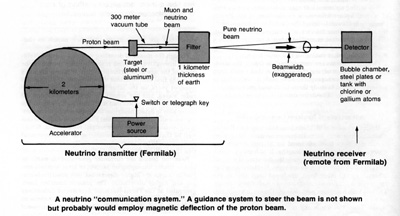 Presently the proton beam generated at Fermilab in the 2 kilometer-diameter ring has energies of 400 billion electron volts. Neutrinos are produced in pulses of 10 billion per pulse with pulses occurring every 8 seconds. The proton beam impinges on a target, resulting in muons, particles of mass intermediate between electrons and protons. The muons travel in a forward direction and their decay products include neutrinos. This forward beam travels through a "filter" of 1 kilometer of earth, which excludes all the particles except neutrinos. To detect the neutrinos, a bubble chamber or an apparatus containing approximately 1,000 tons of steel is used. Even that much steel produces only about 1 interaction per pulse. A person can (and often does) stand in the neutrino beam without any effect on either the person or the beam.
Presently the proton beam generated at Fermilab in the 2 kilometer-diameter ring has energies of 400 billion electron volts. Neutrinos are produced in pulses of 10 billion per pulse with pulses occurring every 8 seconds. The proton beam impinges on a target, resulting in muons, particles of mass intermediate between electrons and protons. The muons travel in a forward direction and their decay products include neutrinos. This forward beam travels through a "filter" of 1 kilometer of earth, which excludes all the particles except neutrinos. To detect the neutrinos, a bubble chamber or an apparatus containing approximately 1,000 tons of steel is used. Even that much steel produces only about 1 interaction per pulse. A person can (and often does) stand in the neutrino beam without any effect on either the person or the beam.
As the proton beam is brought to higher energies, the number of protons per pulse goes up proportionally to the energy. Thus the particle flow (or flux) at a given distance from the ring goes up with two factors of energy from the narrowing of the beam size and one factor of energy from the increase in the number of protons and, thus, neutrinos per pulse. This means that the particle flux goes up with the cube of the energy. For a given neutrino beam the number of interactions in the target is also roughly proportional to the energy. Thus for a one trillion electron volt proton beam, we have calculated that about 50 trillion trillion kilograms (5 x 1025 kilograms or ten times the mass of the earth) of material would have to be located at the distance of Tau Ceti in order to obtain one interaction per day with a neutrino from earth. This is about the rate of Davis' solar neutrino experiment. We are currently comparing prospective fluxes with the natural neutrino background.
With the technology we may expect to have within a few years, we would need ten times the mass of the earth as detector material. However, we must remember that the neutrino pulses are 'on' only about 0.00025 per cent of the time. If this percentage can be raised to even one percent, and the proton beam energy can be brought up another factor of 10, then the detector mass required is less than one millionth the mass of the earth in order to detect one neutrino event per day. This is equivalent to a cubic volume of 100 kilometers on a side, already not too different from the scale of detectors being proposed for Project DUMAND.
We must also allow for further technological development. Already a detection scheme has been suggested that detects muons simultaneously with the Cerenkov radiation. Detecting muons can be achieved by a smaller apparatus. Even though a large detector mass may be required for interaction, the active part (or electronic equipment) involved could be much smaller.
Some investigation of neutrino communication has been underway for sending a neutrino signal through the earth to nuclear submarines on the other side of the earth, but this will require the reduction of the detection apparatus from a cube 100 kilometers on a side to the size of a submarine.
Present Data
Though solar neutrino schemes involve much lower energies than Project DUMAND methods, solar neutrinos represent our longest string of data on interstellar neutrinos. We have examined the Davis records for any sign of obvious messages, and have found none. It seems reasonable that any civilization that chooses to generate strong neutrino beams and point them at a given star would also calculate the appropriate number of neutrinos that inhabitants associated with the star would need in order to
detect the incoming signal. Davis' data involve runs of a month or a few months, with interactions occuring once per day. There is no reason to believe that a neutrino signal need be any shorter in duration than months, nor indeed to be even that short. It seems worthwhile to continue collecting data on a regular basis in order to have long enough data runs to properly search for a signal.
Conclusions
Current plans for neutrino generation coupled with prospective abilities for neutrino detection are beginning to make feasible neutrino messages we might send to be detected at the distances of nearby stars. Though neutrino beams are expensive to generate, this disadvantage may be outweighed by such advantages as very narrow focusing of the transmitted neutrino beam, and the ability to receive from the whole sky simultaneously over a broad range of neutrino energies.
"Though the means of detecting neutrinos are now relatively insensitive, we must remember we are in the dawn of the age of neutrino detection."
On earth, neutrino communications have lagged radio communications by about 100 years, during which time our ability to send and receive radio signals has increased drastically. We can hope for similar improvements in neutrino communications in the next decades.
Technologically the transmission of strong modulated neutrino signals would be a sure sign of an advanced civilization, and we should be looking for such a signal.
Since our transmission of a neutrino signal would involve finding a way of making the neutrino beam track the stars to a high degree of accuracy, the transmission of neutrino signals from earth seems farther in the future.
It may be that neutrino communication is best suited for finding another civilization, after which dialogue could be carried out by electromagnetic means. In any case, if our reasoning of the advantages of neutrino communication is correct, then much of the information now criss-crossing the galaxy could be in this mode.
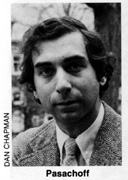 Jay M. Pasachoff is Director of the Hopkins Observatory and Associate Professor of Astronomy at Williams College in Williamstown, Massachusetts, where he has been since 1972. Born in New York City in 1943, he received his Ph.D. from Harvard University, and served on the staffs of the Air Force Cambridge Research Laboratory, the Harvard College Observatory, and the Hale Observatories before going to Williams. His major research fields are solar physics and the relation of radio astronomy to cosmology. He is author of the widely-used astronomy texts "Contemporary Astronomy" and "Astronomy Now". Pasachoff's collaboration with Kutner in expanding "Contemporary Astronomy" into a mathematical version, "University Astronomy", led to this article. Pasachoff and Kutner's first mention of the use of neutrinos for communication on an extraterrestrial scale appears in "University Astronomy".
Jay M. Pasachoff is Director of the Hopkins Observatory and Associate Professor of Astronomy at Williams College in Williamstown, Massachusetts, where he has been since 1972. Born in New York City in 1943, he received his Ph.D. from Harvard University, and served on the staffs of the Air Force Cambridge Research Laboratory, the Harvard College Observatory, and the Hale Observatories before going to Williams. His major research fields are solar physics and the relation of radio astronomy to cosmology. He is author of the widely-used astronomy texts "Contemporary Astronomy" and "Astronomy Now". Pasachoff's collaboration with Kutner in expanding "Contemporary Astronomy" into a mathematical version, "University Astronomy", led to this article. Pasachoff and Kutner's first mention of the use of neutrinos for communication on an extraterrestrial scale appears in "University Astronomy".
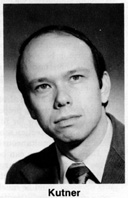 Marc L. Kutner is Associate Professor of Physics at the Rensselaer Polytechnic Institute in Troy, New York. Born in
New York City in 1947, he attended Princeton University for his B.A., and received his Ph.D. from Columbia University. He
was a post-doctoral fellow at NASA's Goddard Institute for Space Studies in New York and was on the Columbia faculty before going to Rensselaer in 1975. His major research field is the radio astronomical study of the interstellar medium. He and Pasachoff have expanded their collaboration into the writing of a new introductory physics text, "Contemporary Physics," for non-major freshmen.
Marc L. Kutner is Associate Professor of Physics at the Rensselaer Polytechnic Institute in Troy, New York. Born in
New York City in 1947, he attended Princeton University for his B.A., and received his Ph.D. from Columbia University. He
was a post-doctoral fellow at NASA's Goddard Institute for Space Studies in New York and was on the Columbia faculty before going to Rensselaer in 1975. His major research field is the radio astronomical study of the interstellar medium. He and Pasachoff have expanded their collaboration into the writing of a new introductory physics text, "Contemporary Physics," for non-major freshmen.
![[NAAPO Logo]](../../Images/NAAPOsm.jpg)
![[NAAPO Logo]](../../Images/NAAPOsm.jpg)